The Snapdragon 865 Performance Preview: Setting the Stage for Flagship Android 2020
by Andrei Frumusanu on December 16, 2019 7:30 AM EST- Posted in
- Mobile
- Qualcomm
- Smartphones
- 5G
- Cortex A77
- Snapdragon 865
Machine Learning Inference Performance
AIMark 3
AIMark makes use of various vendor SDKs to implement the benchmarks. This means that the end-results really aren’t a proper apples-to-apples comparison, however it represents an approach that actually will be used by some vendors in their in-house applications or even some rare third-party app.

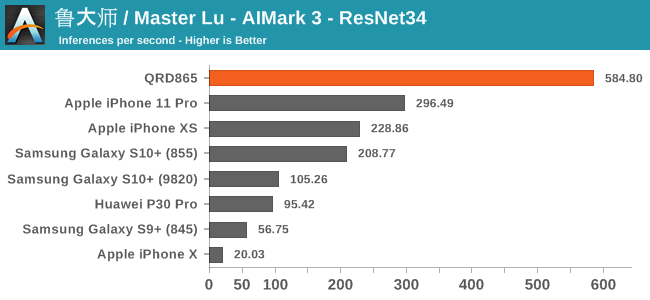
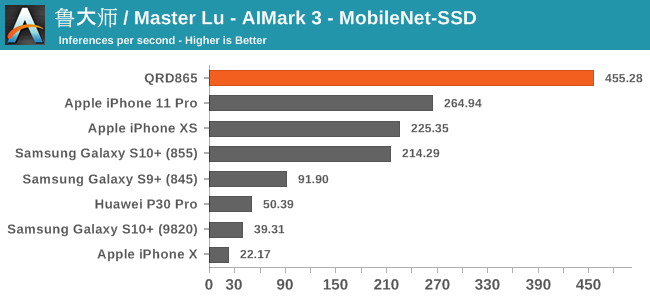
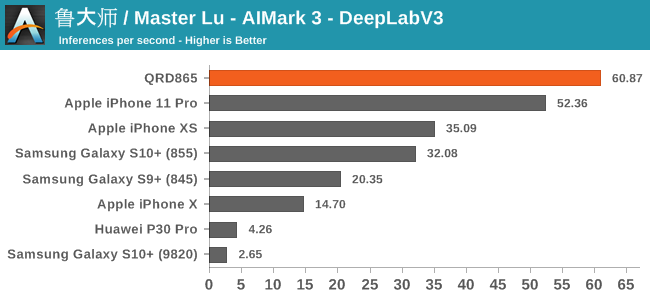
In AIMark 3, the benchmark uses each vendor’s proprietary SDK in order to accelerate the NN workloads most optimally. For Qualcomm’s devices, this means that seemingly the benchmark is also able to take advantage of the new Tensor cores. Here, the performance improvements of the new Snapdragon 865 chip is outstanding, posting in 2-3x performance compared to its predecessor.
AIBenchmark 3
AIBenchmark takes a different approach to benchmarking. Here the test uses the hardware agnostic NNAPI in order to accelerate inferencing, meaning it doesn’t use any proprietary aspects of a given hardware except for the drivers that actually enable the abstraction between software and hardware. This approach is more apples-to-apples, but also means that we can’t do cross-platform comparisons, like testing iPhones.
We’re publishing one-shot inference times. The difference here to sustained performance inference times is that these figures have more timing overhead on the part of the software stack from initialising the test to actually executing the computation.
AIBenchmark 3 - NNAPI CPU
We’re segregating the AIBenchmark scores by execution block, starting off with the regular CPU workloads that simply use TensorFlow libraries and do not attempt to run on specialized hardware blocks.
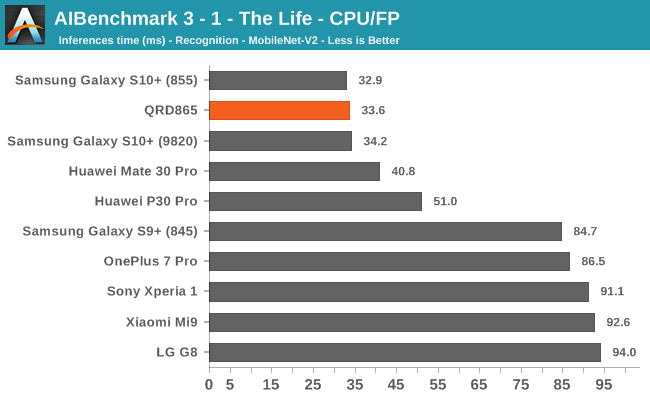
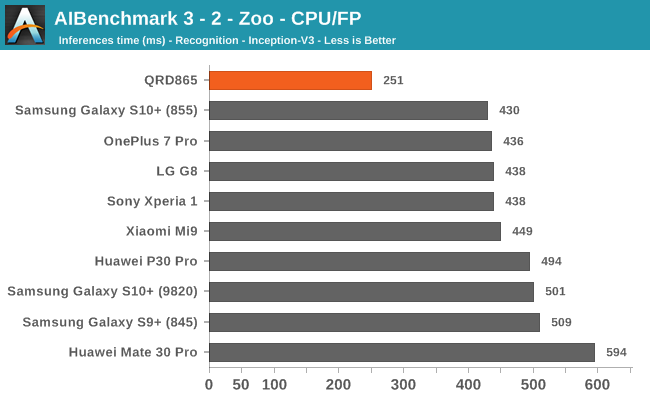

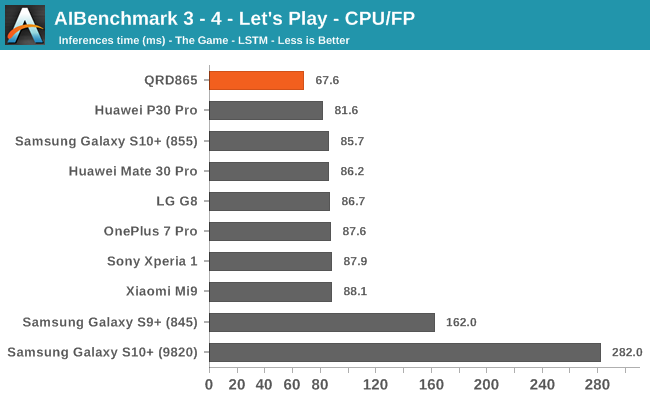

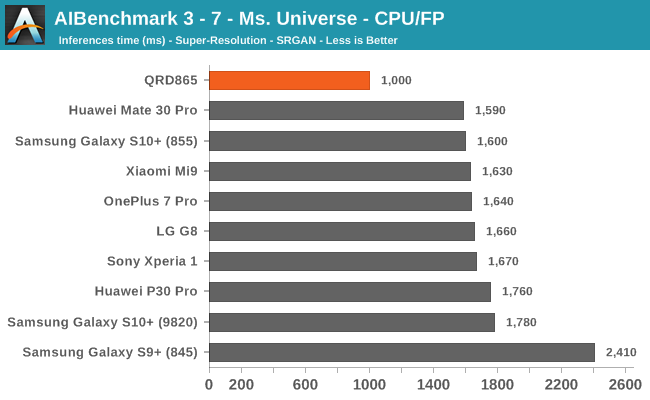

Starting off with the CPU accelerated benchmarks, we’re seeing some large improvements of the Snapdragon 865. It’s particularly the FP workloads that are seeing some big performance increases, and it seems these improvements are likely linked to the microarchitectural improvements of the A77.
AIBenchmark 3 - NNAPI INT8
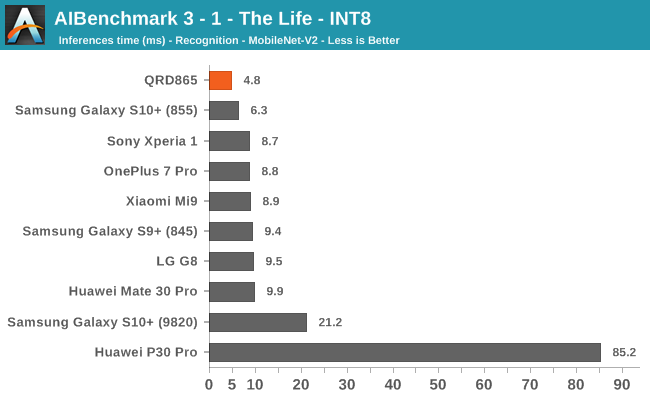
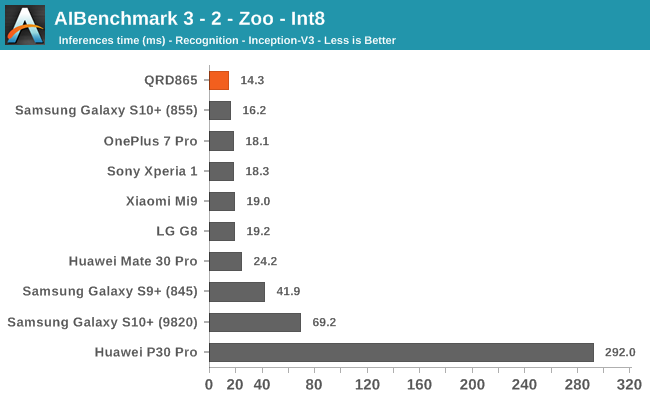
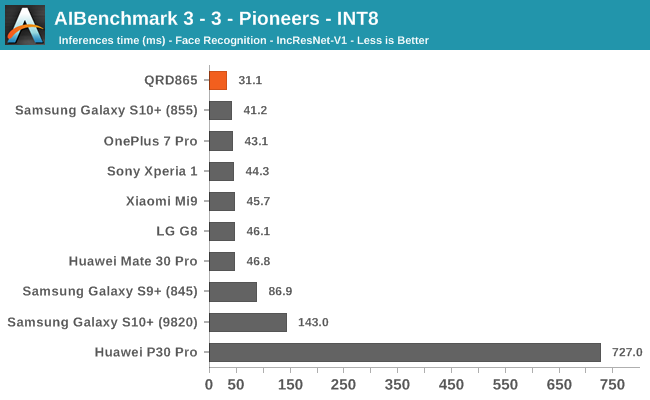
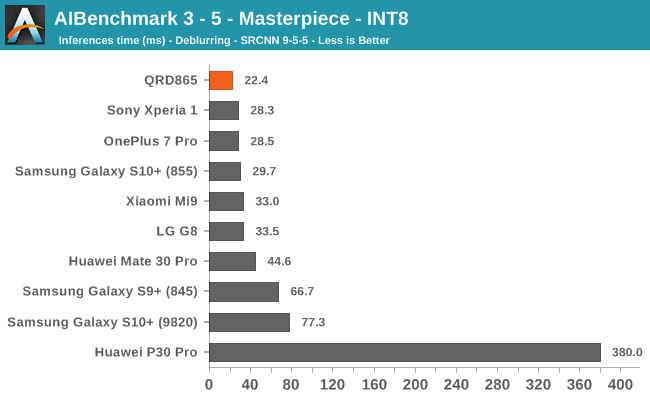
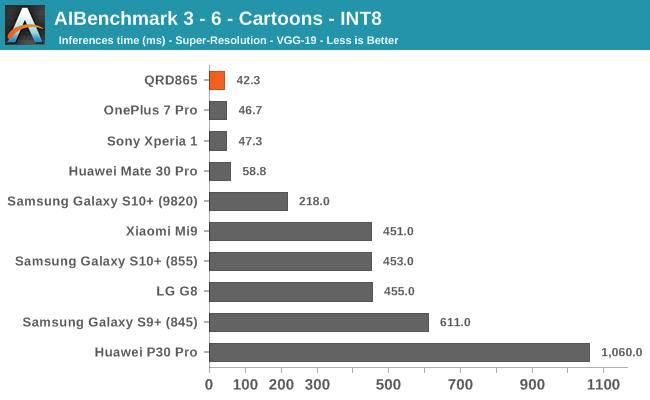
INT8 workload acceleration in AI Benchmark happens on the HVX cores of the DSP rather than the Tensor cores, for which the benchmark currently doesn’t have support for. The performance increases here are relatively in line with what we expect in terms of iterative clock frequency increases of the IP block.
AIBenchmark 3 - NNAPI FP16
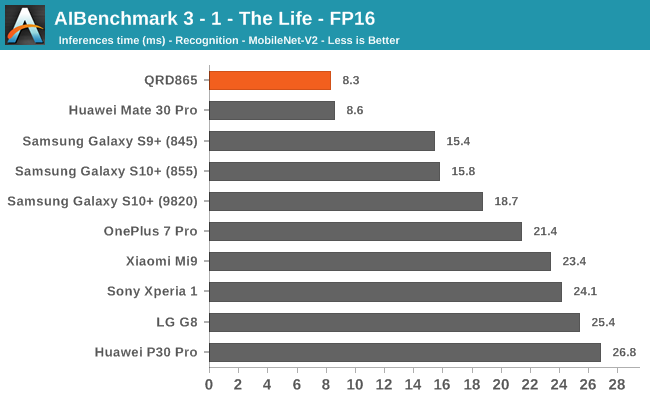
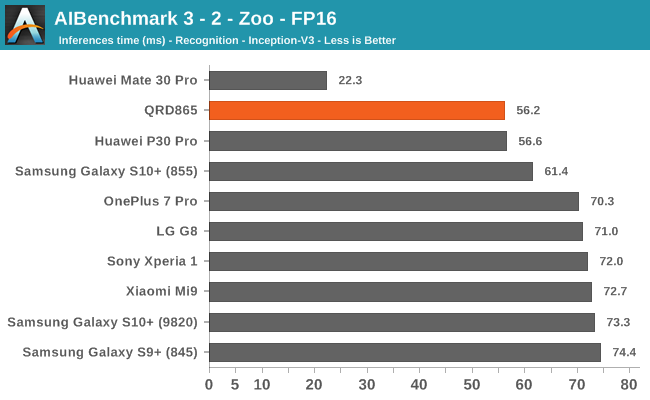
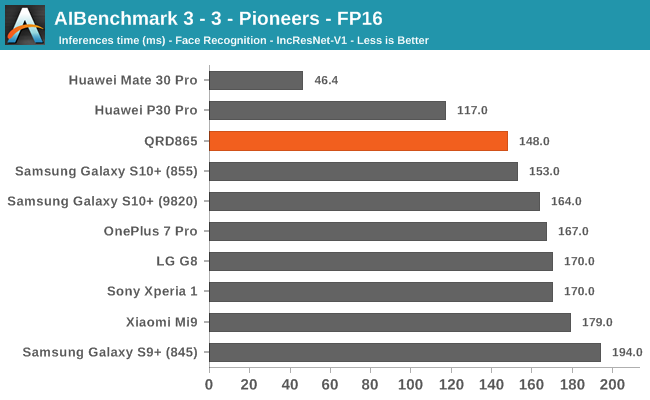
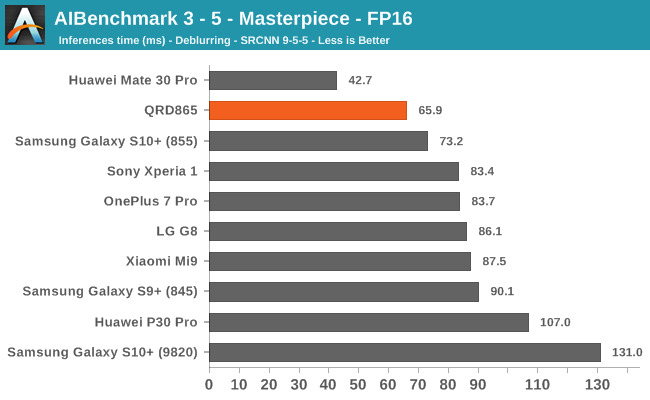
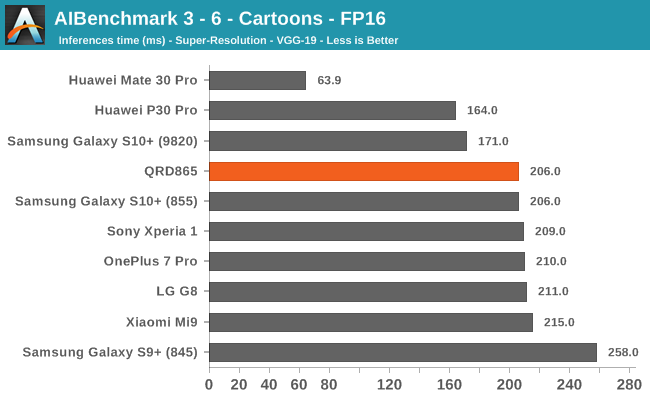
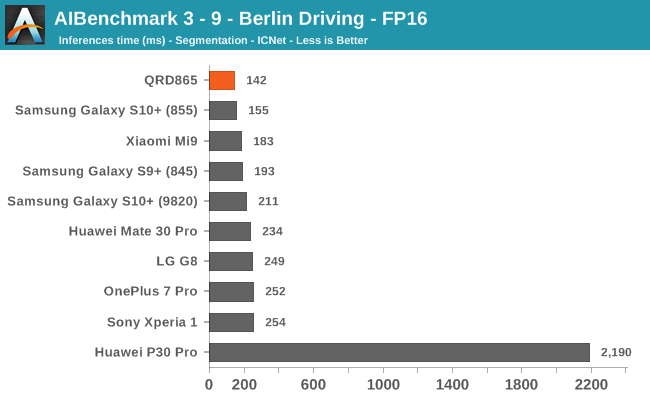
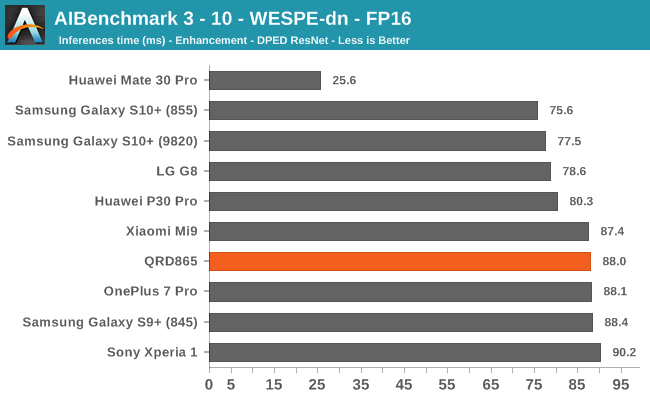
FP16 acceleration on the Snapdragon 865 through NNAPI is likely facilitated through the GPU, and we’re seeing iterative improvements in the scores. Huawei’s Mate 30 Pro is in the lead in the vast majority of the tests as it’s able to make use of its NPU which support FP16 acceleration, and its performance here is quite significantly ahead of the Qualcomm chipsets.
AIBenchmark 3 - NNAPI FP32
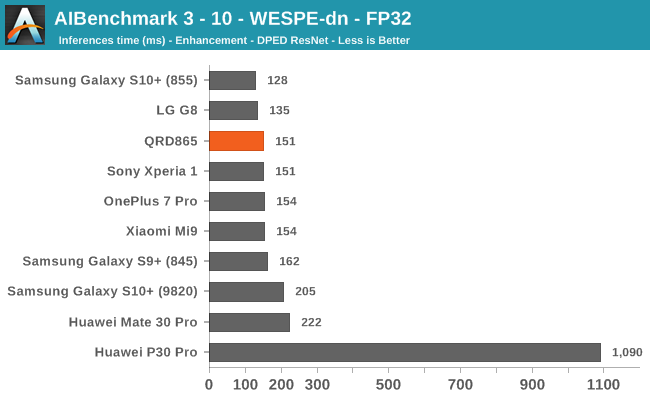
Finally, the FP32 test should be accelerated by the GPU. Oddly enough here the QRD865 doesn’t fare as well as some of the best S855 devices. It’s to be noted that the results here today were based on an early software stack for the S865 – it’s possible and even very likely that things will improve over the coming months, and the results will be different on commercial devices.
Overall, there’s again a conundrum for us in regards to AI benchmarks today, the tests need to be continuously developed in order to properly support the hardware. The test currently doesn’t make use of the Tensor cores of the Snapdragon 865, so it’s not able to showcase one of the biggest areas of improvement for the chipset. In that sense, benchmarks don’t really mean very much, and the true power of the chipset will only be exhibited by first-party applications such as the camera apps, of the upcoming Snapdragon 865 devices.










178 Comments
View All Comments
Alistair - Tuesday, December 17, 2019 - link
go into your BIOS and run your Intel computer in dual core mode, 2.6Ghz, and come back and tell me it is fast...id4andrei - Wednesday, December 18, 2019 - link
The software running on these platforms in not identical. Some of it depends on CPU extensions that are not equivalent between platforms. A dual core 2.6 Ghz intel chip will run slower Win10 than an ipad pro would run ios. But you could find a Linux distribution and some oss apps that would run very fast on that 2.6 Ghz dual core intel.Quantumz0d - Tuesday, December 17, 2019 - link
LOL. You won the most stupid comment here congrats."Android fanatics" so you are an Apple sheep I guess.
Sandybridge OCed to 4GHz+ still keeps up with a 1080Ti without any issues. That shows how Intel milked and Ryzen caught up due to monopoly. And you are crippling an x86 LGA socket processor to 2.6GHz Dual core and compare with an iPad Pro ? In what usecase ? What is the ultimate goal here ? Lets disable all Lightning and Thunder cores and run 1 Lightning then (You cant do it anyways since Apple is the overlord here). What the actual fuck lmao. Also magically slapping in more A13 cores means x86 Intel and AMD are dead, haha you think this is making a sandwich at home ? I thinm you never heard of Sparc or IBM Power go and read snd get your mind blown on threads but do not compare that to x86 or Apple A series Alien technology please. An iOS cannot even process zip file extraction nor a config file for a VPN. That alone breaks the whole A series King to ashes as its not used in a real computer at all. A psuedo Filesystem and fake filemanager app doesn't make it a proper OS. Unfortunately Android is also following same.retarded path thanks to Apple disease at Google emulating by the abomination called Scoped Storage disaster.
Let me tell you a secret the laptop you used all are garbage and they are cut down bottom barrel silicon from the failed Desktop chips and so on. The age of rPGA Intel is fucked (Last XM is 4930MX, a true binned Mobile Chip like K) Thanks to BGA greed of Apple infecting Intel for max profits and people to be subverted to use BGA / soldered trash throttling thin and light crappy planned obsolescence HW.
Let us run a Cinebench on your beloved processor then or lets run a POVray or a H264 Transcoding. Well how about we game a PUBG and stream it at 1080P highest quality.
This is the reason why I see x86 vs ARM talk irrelevant and often AT articles are quoted to prove the IPC and all SPEC scores but completely ignore scalability, compatibility, legacy code, HW market etc, when the compute workloads / OS / Software Code / HW which are entirely different world. Like comparing a Jet fighter to a Jet ski.
Alistair - Tuesday, December 17, 2019 - link
Nice rant. Might want to read my comment before going off like a crazy person? I said I only buy Android phones... right there in the first sentence.Before you blindly state how amazing x86 CPUs are, as I said, run your Intel CPU in dual core mode at 2.6 Ghz and compare how slow it is vs. the A13 Apple chip that is also 2 power cores at a low frequency. That's what IPC is. I can't understand why people get so triggered about saying Apple has the highest IPC in the industry. It's a simple fact and I just have to assume you don't know what you are talking about. Andrei's articles always seem to attract the most illiterate part of the internet.
markol4 - Monday, December 23, 2019 - link
A13 IPC is superior to Intel or AMD but Apple CPU core is huge in terms of transistors budget. IIRC in A11 times Apple CPU core had at least 2 times more transistors than x86 CPU core. Considering that there is no surprise that Apple has a higher IPC.imaheadcase - Tuesday, December 17, 2019 - link
They might as well just make a chart and put "BUZZWORDS" on it at this point.That is what is so silly about current state of smart phones. So much they can cram into one..but rarely do they do..or if they do its crippled by terrible software.
Google is already facing so much criticism of Google Photos bullshit, months in and they just say "we are aware of it". lol
imaheadcase - Tuesday, December 17, 2019 - link
I don't think i'll ever understand how Google can take a product, that works great, then release a dozen updates with release notes that "fixes bugs" and completely borks it for users. I mean what is the fucking incentive. Oh and because everything google is so entwined with other software, for whatever reason, it fucks up other things. So now you try to figure out what software is the original culprit or is it the others now. This shit never ends with google.Nicon0s - Wednesday, December 18, 2019 - link
Do you know what's amusing?The vast majority of people reading this article don't really understand what those numbers showed by the SPEC actually mean, what they represent for the functionality of the phone. Most only copy paste things form the article that they like, especially the parts where it's mentioned that the Qualcomm chips are "years" behind. So it doesn't matter how the phone runs and how fast it can execute real world tasks.
One thing I don't understand is if I would buy a Galaxy S11+ instead of an iphone 11 Pro Max what will I be missing in terms of performance? What specific advantage would the A13 SOC give me because "it's years ahead" in performance?
cha0z_ - Friday, December 27, 2019 - link
My second hand iphone 6s runs super smooth, including in heavy beautiful games - no fps drops or performance issues. Doing so on Galaxy s6 (the available competition model from the same year) is not possible.This is where the powerful SOC shines - years down the road where the phone stays relevant and a pleasure to use. Ofc you will not have to worry about that with your S11+ as samsung support their phones fully for only two years (3rd is security updates only). Really they drop the phone as full/serious support even before the first year drops - this is what happened with my note 9, no attention at all - just quick security updates and no interest beyond that. After all - they put the capable engineers to work only towards the new upcoming phones. Apple support FULLY their phones for 5-6 years + they released this summer a security update for iphone 5 and 4s - 2011 and 2012 model. Any android phone from those years receiving a security update?
Also you can play full PC civilization 6 game on the iphone. No android port and not only because piracy, but because on later turns/bigger maps the android SOCs will choke and the wait time between turns - unbearable. I can list you also a lot more games exclusive to ios, a lot because of performance. Dead cells for example, keeping in touch with the devs - the mobile port dev team (it's outsourced) struggles BIG TIME with performance on android thus massively delaying it.
tranceazure1814 - Tuesday, December 17, 2019 - link
So the main point that I want to know,is it worth upgrading to a Snapdragon 865 over a Snapdragon 855 and while we on the subject does the mi mix 3 5g has less LTE bands than the standard snapdragon 845 mi mix 3?